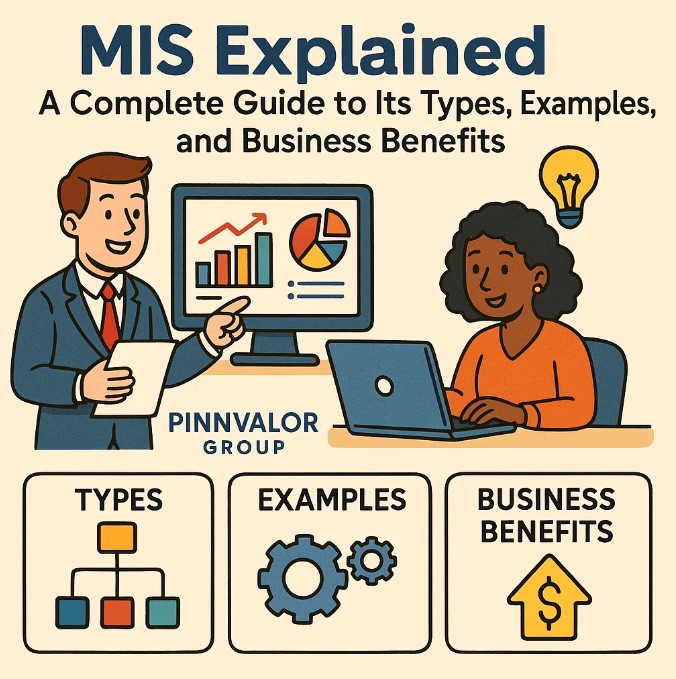
MIS Explained: A Complete Guide to Its Types, Examples, and Business Benefits
In today’s digital-first business environment, information is power—and how that information is managed often defines a company’s efficiency, agility, and long-term success. That’s where Management Information Systems (MIS) come into play. Far from being just a back-office IT function, MIS has evolved into a strategic asset, driving smarter decisions and streamlined operations.
What if a single system could turn your business data into your biggest competitive advantage?
The future belongs to data-driven organizations. With MIS, businesses gain transparency, improve collaboration, and unlock powerful competitive advantages that fuel success.
This blog provides a comprehensive guide to MIS—what it is, the different types, practical examples, and the real-world benefits it offers to organizations across industries.
What is MIS (Management Information System)?
A Management Information System (MIS) is a structured, integrated system that collects, processes, stores, and distributes information to support decision-making, coordination, control, analysis, and visualization in an organization.
At its core, MIS transforms raw data into meaningful information that managers and executives can use to plan, monitor, and evaluate business activities.
Key Components of MIS:
- People – Users who interact with the system (e.g., managers, analysts, IT staff)
- Data – Raw facts and figures collected from business processes
- Processes – Methods for collecting, processing, and storing data
- Hardware – Physical devices such as servers, computers, and networking equipment
- Software – Applications and tools for data processing and analysis
Why MIS Matters
- Improves Decision-Making: MIS provides timely and accurate information that aids in strategic, tactical, and operational decisions.
- Enhances Efficiency: Automation of data collection, reporting, and analysis minimizes manual work and reduces errors.
- Boosts Productivity: Managers can focus on strategy instead of administrative tasks, improving overall output.
- Promotes Transparency and Accountability: Clear data flows make it easier to monitor performance and detect irregularities.
- Supports Competitive Advantage: Data-driven decisions often lead to faster innovation and better market positioning.
Types of MIS
MIS can be classified into several types based on the level and function of management it serves:
- Transaction Processing Systems (TPS): Handle routine, day-to-day operations like payroll, order processing, and invoicing.
Example: Point-of-sale (POS) systems in retail stores. - Management Reporting Systems (MRS): Provide periodic reports and summaries to middle management.
Example: Sales performance dashboards showing monthly or quarterly trends. - Decision Support Systems (DSS): Aid in complex decision-making using data modeling, simulations, and "what-if" analyses.
Example: Financial modeling software used to evaluate investment options. - Executive Information Systems (EIS): Offer high-level overviews with drill-down capabilities for top executives.
Example: Real-time performance monitoring systems for CEOs and CFOs. - Customer Relationship Management Systems (CRM): Manage customer interactions, sales pipelines, and support tickets.
Example: Salesforce, HubSpot. - Enterprise Resource Planning Systems (ERP): Integrate all core processes (finance, HR, manufacturing, etc.) into a single system.
Example: SAP, Oracle ERP.
Real-World Examples of MIS in Action
- Retail Sector: Walmart uses MIS to optimize inventory management by tracking real-time sales and automating restocking processes.
- Banking Industry: Banks use MIS to analyze transaction data, manage risk, and offer personalized financial services.
- Healthcare: Hospitals implement MIS to track patient records, manage scheduling, and monitor treatment outcomes.
- Manufacturing: MIS helps manage supply chains, production schedules, and quality control.
- Education: Universities use MIS to manage admissions, track student progress, and allocate resources efficiently.

Benefits of Implementing MIS
| Benefit | Description |
|---|---|
| Better Planning and Forecasting | Data trends help anticipate future demands and allocate resources more effectively. |
| Faster Reporting | Reports can be generated in minutes rather than days. |
| Cost Efficiency | Automating routine tasks reduces operational costs. |
| Improved Data Accuracy | Centralized systems reduce the chances of human error. |
| Enhanced Collaboration | Data accessibility across departments fosters coordination and teamwork. |
Challenges in MIS Implementation
- High initial investment costs
- Resistance to change among employees
- Integration with legacy systems
- Data privacy and security risks
- Requirement for continuous maintenance and updates
Conclusion
Management Information Systems are no longer optional in the digital economy—they’re essential. From small businesses to multinational corporations, MIS empowers organizations to turn data into insight, insight into action, and action into measurable results.
By understanding its types, real-world use cases, and tangible benefits, business leaders can harness MIS to build more agile, data-driven organizations prepared for tomorrow’s challenges.
